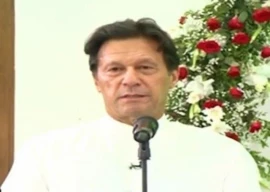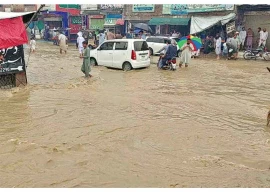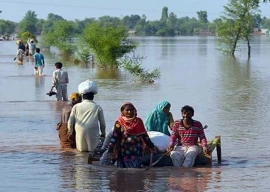
Prime Minister Shahbaz Sharif said on Friday the recent rains in the country broke all previous records and the devastation it caused was more than one could imagine, stressing that this was not the time to blame each other but join hands to help the affected masses.
Talking to reporters during a visit to Sukkur district to assess the flood situation in Sindh, the prime minister noted that the Pakistan Meteorological Department (PMD) had warned of heavy downpours but no-one had anticipated that the rains would break the record of the last three decades in Sindh.
He said that devastation caused by the ongoing floods was much more than the damages in the 2010 super flood in the province. “I would say, it will not be possible to assess all the losses,” Shehbaz said. “A large number of people have died and scores of others have been injured,” he added.
The prime minister acknowledged that the PMD had intimated about the upcoming heavy downpours. However, he said that no government functionary had anticipated that the rains would wreak such a havoc. The rain in Sindh was three to four times more than the average monthly rainfall in August.
“Sindh hasn’t seen devastation on such a scale before. The crops have been destroyed and the cattle perished,” he said, referring to livelihood problem for millions of people, which had been created by the rain and the ensuing floods.
He announced that Rs1 million compensation would be given to the families of each of the deceased. He said that he had given a week’s time to the Benazir Income Support Program (BISP) to distribute Rs25,000 to every rain-affected and displaced family in Sindh.
He told the media that the government had earmarked Rs28 billion funds to cope with the flood situation but added that the amount would be increased. He also announced Rs15 billion grant for Sindh government, which the province could utilise on its discretion for the rehabilitation of the affected people.
To provide immediate relief to the marooned people, the prime minister said that 80 tons of bottled water was being distributed in Sindh and another 20 tons of water in Balochistan. Similarly, he added, 1.5 million mosquito nets are being distributed in Sindh and 500,000 nets in Balochistan.
Shehbaz appealed to the well-off people of the country, especially the industrialists and traders of all the big cities to come forward and help the flood victims. He appealed to them to either deposit funds in the Prime Minister’s Relief Fund or personally reach out to the affected people.
He noted that the army and navy were already engaged in the rescue and relief works and suggested that the framework under which the army engaged in the rescue and relief works in 2010 and 2011 floods should be followed. He observed that the army chief had also visited Karachi in this regard.
Emphasising that “This is not the time to blame someone but to help each other,” the prime minister announced that the government had set short-, medium- and long-term targets to help the affected people. In the first step, Shehbaz said, the marooned people were being rescued and provided relief.
“This will be followed by rehabilitation of the people to restart their lives in their homes and cultivate their crops with the help of government provided compensation,” he added. The long-term goals consisted of reconstruction of all the damaged infrastructure, he continued.
The prime minister believed that the first phase should conclude in a week or two and the second in 30 to 45 days. However, rebuilding the infrastructure would not only require time but also the funds, for which he prayed the Almighty to help the coalition government.
Responding to a question, Shehbaz said that construction of more dams and reservoirs in the north would help prevent floods in future and more water could be stored. Asked further about the construction of a new barrage to replace the ageing Sukkur barrage, Shehbaz said that the barrage was still strong.
The prime minister told reporters that before coming to Sukkur, he met with the ambassadors of friendly countries, including those from the Middle East, US, UK, Japan, Germany and China, who had assured him of their support.
Foreign Minister Bilawal Bhutto Zardari, who is also the chairman of the Pakistan Peoples Party (PPP), federal ministers Maryam Aurangzeb and Khurram Dastagir Khan, Chief Minister Syed Murad Ali Shah and PPP’s senior leader Syed Khursheed Shah were also present on the occasion.
During the visit, Bilawal requested the prime minister to end load-shedding in the flood-hit districts for early dewatering. Shehbaz said that instruction in this regard had already been given by the power minister Khurram Dastgir.
Sindh Chief Minister Syed Murad Ali Shah thanked the prime minister for the disbursement of compensation money to flood victims through the BISP. At present, he said, tents were the most-needed commodity and appealed to philanthropists to come forward with their contribution.
Jamiat Ulema-e-Islam’s General Secretary Sindh chapter Rashid Mehmood Soomro on the occasion stressed the need for joint efforts of the federal and provincial governments besides the private sector to help the flood victims.
The district administration of Sukkur and the representatives of the Provincial Disaster Management Authority (PDMA) briefed the prime minister about the ongoing work for the relief of the flood-stricken people and the rehabilitation of infrastructure.
The deputy commissioner sought financial support from the prime minister to complete the second phase of the drainage project which, he said, would resolve 90% of Sukkur’s drainage problem. He said that Sukkur city was below the Indus level, therefore, the drainage was a problem.
The prime minister also took an aerial view of the inundated areas of Sukkur, Rohri, Khairpur, Faiz Ganj, Kot Diji, and Thari Mir Wah. He directed the officials concerned that relief and rescue staff must remain on duty round-the-clock to help the flood survivors.
(WITH INPUT FROM APP)

1719660634-1/BeFunky-collage-nicole-(1)1719660634-1-405x300.webp)

1732276540-0/kim-(10)1732276540-0-165x106.webp)

1732274008-0/Ariana-Grande-and-Kristin-Chenoweth-(1)1732274008-0-165x106.webp)

1724249382-0/Untitled-(640-x-480-px)1724249382-0-270x192.webp)


1732270499-0/Express-Tribune-(7)1732270499-0-270x192.webp)
1732267715-0/BeFunk_§_]__-(32)1732267715-0.jpg)










COMMENTS (1)
Comments are moderated and generally will be posted if they are on-topic and not abusive.
For more information, please see our Comments FAQ